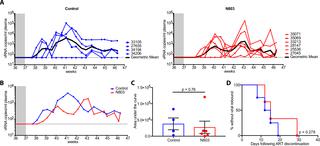当前位置:
X-MOL 学术
›
PLOS Pathog.
›
论文详情
Our official English website, www.x-mol.net, welcomes your feedback! (Note: you will need to create a separate account there.)
The human IL-15 superagonist N-803 promotes migration of virus-specific CD8+ T and NK cells to B cell follicles but does not reverse latency in ART-suppressed, SHIV-infected macaques.
PLoS Pathogens ( IF 6.7 ) Pub Date : 2020-03-12 , DOI: 10.1371/journal.ppat.1008339 Gabriela M Webb 1, 2 , Jhomary Molden 3 , Kathleen Busman-Sahay 1, 2 , Shaheed Abdulhaqq 1, 2 , Helen L Wu 1, 2 , Whitney C Weber 1, 2 , Katherine B Bateman 1, 2 , Jason S Reed 1, 2 , Mina Northrup 1, 2 , Nicholas Maier 1, 2 , Shiho Tanaka 4 , Lina Gao 2 , Brianna Davey 3 , Benjamin L Carpenter 3 , Michael K Axthelm 1 , Jeffrey J Stanton 2 , Jeremy Smedley 1, 2 , Justin M Greene 1, 2 , Jeffrey T Safrit 5 , Jacob D Estes 1, 2 , Pamela J Skinner 3 , Jonah B Sacha 1, 2
PLoS Pathogens ( IF 6.7 ) Pub Date : 2020-03-12 , DOI: 10.1371/journal.ppat.1008339 Gabriela M Webb 1, 2 , Jhomary Molden 3 , Kathleen Busman-Sahay 1, 2 , Shaheed Abdulhaqq 1, 2 , Helen L Wu 1, 2 , Whitney C Weber 1, 2 , Katherine B Bateman 1, 2 , Jason S Reed 1, 2 , Mina Northrup 1, 2 , Nicholas Maier 1, 2 , Shiho Tanaka 4 , Lina Gao 2 , Brianna Davey 3 , Benjamin L Carpenter 3 , Michael K Axthelm 1 , Jeffrey J Stanton 2 , Jeremy Smedley 1, 2 , Justin M Greene 1, 2 , Jeffrey T Safrit 5 , Jacob D Estes 1, 2 , Pamela J Skinner 3 , Jonah B Sacha 1, 2
Affiliation

|
Despite the success of antiretroviral therapy (ART) to halt viral replication and slow disease progression, this treatment is not curative and there remains an urgent need to develop approaches to clear the latent HIV reservoir. The human IL-15 superagonist N-803 (formerly ALT-803) is a promising anti-cancer biologic with potent immunostimulatory properties that has been extended into the field of HIV as a potential "shock and kill" therapeutic for HIV cure. However, the ability of N-803 to reactivate latent virus and modulate anti-viral immunity in vivo under the cover of ART remains undefined. Here, we show that in ART-suppressed, simian-human immunodeficiency virus (SHIV)SF162P3-infected rhesus macaques, subcutaneous administration of N-803 activates and mobilizes both NK cells and SHIV-specific CD8+ T cells from the peripheral blood to lymph node B cell follicles, a sanctuary site for latent virus that normally excludes such effector cells. We observed minimal activation of memory CD4+ T cells and no increase in viral RNA content in lymph node resident CD4+ T cells post N-803 administration. Accordingly, we found no difference in the number or magnitude of plasma viremia timepoints between treated and untreated animals during the N-803 administration period, and no difference in the size of the viral DNA cell-associated reservoir post N-803 treatment. These results substantiate N-803 as a potent immunotherapeutic candidate capable of activating and directing effector CD8+ T and NK cells to the B cell follicle during full ART suppression, and suggest N-803 must be paired with a bona fide latency reversing agent in vivo to facilitate immune-mediated modulation of the latent viral reservoir.
中文翻译:

人类IL-15超激动剂N-803促进病毒特异性CD8 + T和NK细胞向B细胞滤泡的迁移,但不能逆转ART抑制的SHIV感染猕猴的潜伏期。
尽管抗逆转录病毒疗法(ART)能够成功阻止病毒复制并减缓疾病进展,但这种治疗方法仍无法治愈,因此迫切需要开发一些方法来清除潜在的HIV病毒库。人IL-15超激动剂N-803(以前为ALT-803)是一种具有前瞻性的抗癌生物制剂,具有强大的免疫刺激特性,已被扩展到HIV领域,作为治疗HIV的潜在“休克杀手”。但是,在ART的掩护下,N-803在体内重新激活潜伏病毒和调节抗病毒免疫的能力仍然不确定。在这里,我们显示了在ART抑制的猿猴-人免疫缺陷病毒(SHIV)SF162P3感染的恒河猴中,皮下注射N-803可激活并动员NK细胞和SHIV特异性CD8 + T细胞从外周血转移至淋巴结B细胞滤泡,这是潜伏病毒的庇护所,通常不包括这种效应细胞。我们观察到N-803给药后,记忆CD4 + T细胞的激活最少,并且在淋巴结中的CD4 + T细胞中病毒RNA含量没有增加。因此,我们发现在N-803给药期间,在治疗和未治疗的动物之间,血浆病毒血症时间点的数量或大小没有差异,并且在N-803治疗之后,与病毒DNA细胞相关的储库的大小也没有差异。这些结果证实N-803是一种有效的免疫治疗候选物,能够在完全抑制ART的过程中激活效应CD8 + T和NK细胞并将其引导至B细胞滤泡,
更新日期:2020-03-12
中文翻译:

人类IL-15超激动剂N-803促进病毒特异性CD8 + T和NK细胞向B细胞滤泡的迁移,但不能逆转ART抑制的SHIV感染猕猴的潜伏期。
尽管抗逆转录病毒疗法(ART)能够成功阻止病毒复制并减缓疾病进展,但这种治疗方法仍无法治愈,因此迫切需要开发一些方法来清除潜在的HIV病毒库。人IL-15超激动剂N-803(以前为ALT-803)是一种具有前瞻性的抗癌生物制剂,具有强大的免疫刺激特性,已被扩展到HIV领域,作为治疗HIV的潜在“休克杀手”。但是,在ART的掩护下,N-803在体内重新激活潜伏病毒和调节抗病毒免疫的能力仍然不确定。在这里,我们显示了在ART抑制的猿猴-人免疫缺陷病毒(SHIV)SF162P3感染的恒河猴中,皮下注射N-803可激活并动员NK细胞和SHIV特异性CD8 + T细胞从外周血转移至淋巴结B细胞滤泡,这是潜伏病毒的庇护所,通常不包括这种效应细胞。我们观察到N-803给药后,记忆CD4 + T细胞的激活最少,并且在淋巴结中的CD4 + T细胞中病毒RNA含量没有增加。因此,我们发现在N-803给药期间,在治疗和未治疗的动物之间,血浆病毒血症时间点的数量或大小没有差异,并且在N-803治疗之后,与病毒DNA细胞相关的储库的大小也没有差异。这些结果证实N-803是一种有效的免疫治疗候选物,能够在完全抑制ART的过程中激活效应CD8 + T和NK细胞并将其引导至B细胞滤泡,



























 京公网安备 11010802027423号
京公网安备 11010802027423号